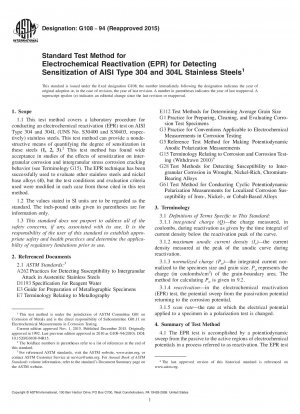ASTM G108-94(2015)
Standard Test Method for Electrochemical Reactivation (EPR) for Detecting Sensitization of AISI Type 304 and 304L Stainless Steels
- Standard No.
- ASTM G108-94(2015)
- Release Date
- 1994
- Published By
- American Society for Testing and Materials (ASTM)
- Status
- Replace By
- ASTM G108-23
- Latest
- ASTM G108-23
- Scope
5.1 This test method describes an EPR test method for quantitatively determining the relative degree of sensitization in AISI Type 304 and 304L stainless steels. The EPR test has found wide use as a means to provide a numerical level of sensitization in studies of the effects of sensitization on intergranular corrosion and intergranular stress corrosion cracking behavior. The results of this test method correlate with other test methods (for example, Practices A262 and Test Methods G28) that are commonly used to assess sensitization in stainless steels.
5.2 The EPR test can also be used for product acceptance, service evaluation, regulatory statutes, and manufacturing controls providing that both the supplier and user have agreed upon appropriate acceptance criteria and a sensitizing treatment. The test is not intended for design purposes since the test conditions accelerate corrosion in a manner that does not simulate any actual service environment.
5.3 The EPR test involves the measurement of the amount of charge resulting from the corrosion of the chromium-depleted regions surrounding the precipitated chromium carbide particles. Most of these particles in a sensitized microstructure are located at the grain boundaries. However, discrete particles located within grains (referred to as intragranular precipitates) will also contribute to the total measured charge. (See Fig. 2.) Therefore, it is important to examine the alloy microstructure following an EPR test to determine the relative proportion of corrosion sites associated with intergranular versus intragranular precipitates. Sites of intergranular attack will appear similar to grain boundary ditching as defined in Practice A of Practices A262.
Note 1: The calculation of Pa is based on the assumptions illustrated at left. Mild cases of sensitization usually result in a combination of intergranular attack and pitting as illustrated at right (6).
1.1 This test method covers a laboratory procedure for conducting an electrochemical reactivation (EPR) test on AISI Type 304 and 304L (UNS No. S30400 and S30403, respectively) stainless steels. This test method can provide a nondestructive means of quantifying the degree of sensitization in these steels (1, 2, 3).2 This test method has found wide acceptance in studies of the effects of sensitization on intergranular corrosion and intergranular stress corrosion cracking behavior (see Terminology G15). The EPR technique has been successfully used to evaluate other stainless steels and nickel base alloys (4), but the test conditions and evaluation criteria used were modified in each case from those cited in this te......
ASTM G108-94(2015) Referenced Document
- ASTM A262 Standard Practices for Detecting Susceptibility to Intergranular Attack in Austenitic Stainless Steels*, 1998-04-20 Update
- ASTM D1193 Standard Specification for Reagent Water*, 1999-04-20 Update
- ASTM E112 Standard Test Methods for Determining Average Grain Size*, 1996-04-20 Update
- ASTM E3 Standard Practice for Preparation of Metallographic Specimens*, 1995-04-20 Update
- ASTM E7 Standard Terminology Relating to Metallography*, 2022-10-01 Update
- ASTM G1 Standard Practice for Preparing, Cleaning, and Evaluating Corrosion Test Specimens*, 1999-01-01 Update
- ASTM G15 Standard Terminology Relating to Corrosion and Corrosion Testing*, 1999-04-20 Update
- ASTM G28 Standard Test Methods of Detecting Susceptibility to Intergranular Corrosion in Wrought, Nickel-Rich, Chromium-Bearing Alloys*, 1997-04-20 Update
- ASTM G3 Standard Practice for Conventions Applicable to Electrochemical Measurements in Corrosion Testing
- ASTM G5 Standard Reference Test Method for Making Potentiostatic and Potentiodynamic Anodic Polarization Measurements
- ASTM G61 Standard Test Method for Conducting Cyclic Potentiodynamic Polarization Measurements for Localized Corrosion Susceptibility of Iron-, Nickel-, or Cobalt-Based Alloys*, 2024-04-20 Update
ASTM G108-94(2015) history
- 2023 ASTM G108-23 Standard Test Methods for Electrochemical Reactivation (EPR) for Detecting Sensitization of AISI Type 304 and 304L Stainless Steels
- 1994 ASTM G108-94(2015) Standard Test Method for Electrochemical Reactivation (EPR) for Detecting Sensitization of AISI Type 304 and 304L Stainless Steels
- 1994 ASTM G108-94(2010) Standard Test Method for Electrochemical Reactivation (EPR) for Detecting Sensitization of AISI Type 304 and 304L Stainless Steels
- 1994 ASTM G108-94(2004)e1 Standard Test Method for Electrochemical Reactivation (EPR) for Detecting Sensitization of AISI Type 304 and 304L Stainless Steels
- 1994 ASTM G108-94(2004) Standard Test Method for Electrochemical Reactivation (EPR) for Detecting Sensitization of AISI Type 304 and 304L Stainless Steels
- 1994 ASTM G108-94(1999) Standard Test Method for Electrochemical Reactivation (EPR) for Detecting Sensitization of AISI Type 304 and 304L Stainless Steels

Copyright ©2024 All Rights Reserved